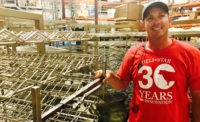Much of a meat processor’s day can be taken up by paperwork — too much paperwork, on some days. It seems counterintuitive that increasing the amount of documentation could improve the business, but that could be the case. Taking on a third-party certification not only could lead to more efficient operations, but it also could open the door to new customers.
Retail chains, including Walmart, Kroger and Publix, are requiring their food suppliers to have GFSI certification. GFSI, or Global Food Safety Initiative, has several types of certifications. Most common in the United States are BRC (British Retail Consortium) and SQF (Safe Quality Food), says Bobby Pace of RDP Consulting. Companies that operate under FSIS inspection (or FDA inspection for non-meat items) were still having recalls, which is disruptive and costly to a retailer. These certifications are designed to help curb those recalls.
“SQF or BRC requires you to go above and beyond what the [state or federal] regulations require,” he says.
Pace says that he sees BRC certifications more frequently in slaughter operations, as it is less facility-oriented than SQF. On the other hand, SQF may be a better choice for a ready-to-eat plant. Unless a specific certification is required by a customer, the processor should investigate the options to see which choice will be less disruptive or costly.
“You clear the requirements of the code, but you do it in a way that doesn’t make it such a burden on your operation,” Pace says. “Most of these things you’re doing anyway; it’s just a matter making sure we document it or do this test to make sure we’re doing the things to make a safe product for our customers or consumers.”
Along with the benefits of additional customer opportunities, certification can also provide a monetary gain by way of process improvements.
“When you have a less variable process, you can find ways in your operation to reduce giveaway, improve yield or reduce rework. You put checks in place, not only from a food safety standpoint, but from a quality standpoint. It’s a drive toward continuous improvement,” Pace says.
Pace does recommend that a plant work with an expert when it comes time to prepare for certification.
“Most plants are short-handed, as everyone is wearing different hats or multiple hats, and they already have a full-time job,” he says, adding that an experienced consultant would have written many BRC or SQF manuals in the past and would understand the requirements.
Preparing for certification can be a six- to nine-month process and should start with a gap assessment. That assessment examines where a company stands and where it needs to be to gain its certification. Once that is prepared, Pace says he gets the company through the documentation and walks the employees through the process they must follow. The BRC certification requires just one audit, whereas SQF involves a desk audit and a facility audit.
Pace has seen cautionary tales in his past, of companies that worked hard to gain their certification and then let the process lag. Not only does that waste the time and money spent gaining the certification in the first place, but it also makes any re-certification harder than it needs to be.
“SQF is something that you live every day, as well as BRC. It needs to be a culture within the operation,” he explains.
“What I’ve seen from companies who take it seriously and fully implement it, they’ll come back in a year and say, ‘You know what? We’re a much better company now. We’re not in a reactive mode, we’re in a proactive mode,’” Pace adds.




Report Abusive Comment